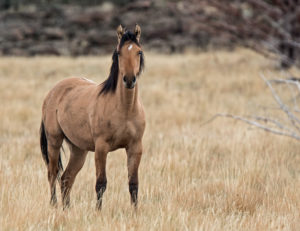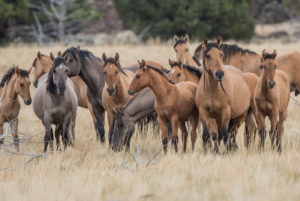The Intriguing Mystery of the Kiger Mustang
by Marlin Greene
The locals had warned me people spend a lot of time looking, but often never find the Kiger Mustangs. Regardless, about half-way up the mountain I see them — maybe twenty or so — casually searching for what little grass is left after a long dry spell. There is no place to pull off the dirt track so I stop in the road and quietly get out with my camera. It’s a slow hike of a quarter mile across a sloping meadow. The horses know I’m there, but allow me into their private estate without protest. They seemed as curious about me as I was interested in them, allowing me to approach and manage some fairly intimate photographs. Observing in awesome silence, I get the feeling that I am intruding on an incomprehensible mystery after about twenty minutes. Politeness dictates that it’s time to leave. I say “thank you for being here,” and turn toward the car.
Imagine arriving in North America, before there was a United States, making your way to the wilderness of the Steens Mountains in eastern Oregon and somehow surviving there undetected for over five hundred years. This is the remarkable achievement of this herd of wild horses. These survivors are the direct descendants of the horses brought to the New World by the gold-hungry conquistadors in the sixteenth century. They were unknown to modern America until they were discovered in 1977 by a Bureau of Land Management (BLM) survey team.

In 1977, while investigating the wild horse herds that roamed the wilderness of eastern Oregon, Ron Harding, a newly appointed wild horse manager at the BLM, discovered a herd of mustangs that looked to be of pure Spanish descent. The herd of twenty-seven horses looked almost alike: all had similar color, conformation, and markings. This included “dun factor,” distinguishing patterns such as tan and gray color overall with black tail, mane and dark lower legs with faint zebra stripes. Here was a herd of pure heritage and blood line that for five hundred years had somehow managed to remain undiscovered and astonishingly unchanged from their ancestors.
Government BLM horse experts agreed that they had discovered a very different and special kind of horse. For preservation’s sake they moved the small band of horses to other areas on the north end of the Steens Mountain, near Kiger Gorge. The Kiger breed takes its name from this region. It was decided to have genetic testing performed to determine their heritage. The DNA testing, done at the University of Kentucky showed a high level of Spanish markers linking them to the Spanish explorers’ horses of the 1600’s. This test result clearly ties the Kigers to the horses ridden by early Spanish Explorers since these DNA markers are not found in any other horse breeds. Only about 200 Kigers are left in their original wild environment. About every four years, when the herds reach their maximum population, the extra horses are rounded up and taken to the Burns, Oregon wild horse corrals where they are made available for adoption to the public.

To reach the wild Kiger Mustang homeland I had to first go to Burns, Oregon in sparsely populated Harney County. I drove southeast from Burns on a smoothly paved highway to the small settlement of Diamond, about 70 miles from Burns as the hawk flies. It’s a journey through a land of hay fields and leaning fence posts strung with barbed wire fences. A good paved road took me through the Diamond Valley and then east into sagebrush and juniper country toward the Steens Mountain wilderness. I found the “Kiger Mustang Viewing Area” sign and took the gravel road that diminishes into a dirt track, long before it completes the eleven miles to the top of the ridge where the mustangs might be seen if one is lucky. I was very lucky.
Many questions traveled down the mountain with me that day: How did these amazing creatures get there? How did they escape their original masters? How did they survive so long undiscovered? What are their dark, inquisitive eyes trying to convey? Perhaps the last question can be answered something like this: Let us live in peace and prosper for another five hundred years. We have endured, isn’t that enough? Let the mystery continue.
Highlight: Marlin Greene is a designer and Nature photographer living in Seattle. He can be reached here:
phone: 206.784.1641
website: www.oneearthimages.com
email: [email protected]
Published January 2014 Issue

The Northwest Horse Source is an independently owned and operated print and online magazine for horse owners and enthusiasts of all breeds and disciplines in the Pacific Northwest. Our contemporary editorial columns are predominantly written by experts in the region, covering the care, training, keeping and enjoyment of horses, with an eye to the specific concerns in our region.






